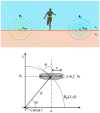An Electromagnetic Sensor for the Autonomous Running of Visually Impaired and Blind Athletes (Part I: The Fixed Infrastructure)
- PMID: 28216570
- PMCID: PMC5336106
- DOI: 10.3390/s17020364
An Electromagnetic Sensor for the Autonomous Running of Visually Impaired and Blind Athletes (Part I: The Fixed Infrastructure)
Abstract
Sport is one of the best ways to promote the social integration of people affected by physical disability, because it helps them to increase their self-esteem by facing difficulties and overcoming their disabilities. Nowadays, a large number of sports can be easily played by visually impaired and blind athletes without any special supports, but, there are some disciplines that require the presence of a sighted guide. In this work, the attention will be focused on marathons, during which athletes with visual disorders have to be linked to the sighted guide by means of a non-stretchable elbow tether, with an evident reduction of their performance and autonomy. In this context, this paper presents a fixed electromagnetic infrastructure to equip a standard running racetrack in order to help a blind athlete to safely run without the presence of a sighted guide. The athlete runs inside an invisible hallway, just wearing a light and a comfortable sensor unit. The patented system has been homemade, designed, realized and finally tested by a blind Paralympic marathon champion with encouraging results and interesting suggestions for technical improvements. In this paper (Part I), the transmitting unit, whose main task is to generate the two magnetic fields that delimit the safe hallway, is presented and discussed.
Keywords: electromagnetic safety; electromagnetic travel aids; visually impaired athletes.
Conflict of interest statement
The authors declare no conflict of interest.
Figures







References
-
- Ray C.T., Horvat M., Williams M., Blasch B.B. Clinical assessment of functional movement in adults with visual impairments. J. Vis. Impair. Blind. 2007;101:108–113.
-
- Holbrook E.A., Caputo J.L., Perry T.L., Fuller D.K., Morgan D.W. Physical activity, body composition, and perceived quality of life. J. Vis. Impair. Blind. 2009;103:17–29.
-
- International Blind Sport Federation. [(accessed on 10 February 2017)]. Available online: http://www.ibsasport.org.
-
- Dakopoulos D., Bourbakis N. Wearable obstacle avoidance electronic travel aids for blind: A survey. IEEE Trans. Syst. Man Cybern. C Appl. Rev. 2010;40:25–35. doi: 10.1109/TSMCC.2009.2021255. - DOI
-
- Scalise L., Primiani V.M., Russo P., Shahu D., Di Mattia V., De Leo A., Cerri G. Experimental investigation of electromagnetic obstacle detection for visually impaired users: A comparison with ultrasonic sensing. IEEE Trans. Instrum. Meas. 2012;61:3047–3057. doi: 10.1109/TIM.2012.2202169. - DOI
MeSH terms
LinkOut - more resources
Full Text Sources
Other Literature Sources

